The History Of Peugeot 405
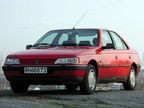
The Peugeot 405 is a large family car released by the French automaker Peugeot in July 1987 and which continues to be manufactured under license outside France. The 405 was voted European Car of the Year for 1988.
It has been available in left-hand and right-hand-drive versions, as a saloon and station wagon, in front-wheel, and four-wheel drive. Designed by Pininfarina, the 405 shares its platform with the Citroën BX that appeared in 1982, although the physical appearance of the two cars is very different.
About 2.5 million vehicles have been sold worldwide. It slotted into the Peugeot range between the smaller 309 and the larger 505, giving it a firm rival for the Ford Sierra and Vauxhall Cavalier/ Opel Vectra.
The 405 was the last Peugeot vehicle sold in the US, the company withdrawing in 1991.
Designed in France, it has been manufactured in:
- Europe: from 1987 to 1997 at Sochaux (France) and Ryton (UK).
- Zimbabwe: until 2002, by Quest.
- Egypt: Wagih Abaza produces the 405, as well as marketing other models.
- Iran: currently produced by Iran Khodro.
- Argentina:Several saloon models, including diesels were built in the Villa Bosch Peugeot facility from 1992 to 1999. In this country the 405 has been an extremely popular car, with total sales of over 500,000 units.
- Poland: Produced by FSO Lublin.
Iranian variants
Iran Khodro also produces several models derived from the 405. The Peugeot Pars, also known as the Peugeot Persia, is a facelifted 405 with a redesigned front end including clear lamp lenses and a revised rear. The Peugeot RD is a rear wheel drive car which has a 405 body and mechanical parts from the Paykan. Since 2006, it has been sold in certain Middle Eastern markets as the Peugeot ROA.
The Samand, which was designed to be a "national car" for Iran, is also based on the 405 platform. It replaced the long-running Paykan which was itself based on the Hillman Hunter, an ancestor (in corporate ownership and model positioning terms) of the 405, having been produced by the Rootes Group and Chrysler UK from 1963 until 1979 - the year that Peugeot purchased Chrysler's European operations.
- 1987: In July, Peugeot unveiled 10 versions of the 405 simultaneously for the 1988 model year. The 405 was available as a 4-door only. Four-cylinder petrol engines included 65, 92, 110, 125, and 160 hp (48, 69, 82, 93, and 119 kW) units.
- 1988: 70 and 90 hp (52 and 67 kW) diesel engines are added to the range. Estate introduced.
- 1989: 500,000 vehicles already produced.
- 1990: In France, the 1 millionth 405 leaves the Sochaux factory. BE1 transmission replaced by the BE3.
- 1991: Updates to the dashboard, steering wheel, and soundproofing.
- 1993: Phase 2 model. New boot (trunk) with better ingress, new rear lights and boot design and new dashboard. Launch of the turbocharged, 16-valve, four wheel drive 405 T16. (LHD only)
- 1995: The 405's replacement, the 406 is introduced. 405 saloon discontinued. Airbag becomes an option on some models, and standard on the Mi16 (except UK) and T16.
- 1997: Estate discontinued in Europe, marking the end of European production of the 405.
Versions
UK Market
1988-1992 range
- GE - 1.6 L 8-valve, basic model
- Style - 1.6 L 8-valve, basic model, UK market only
- GL/ GR - 1.6L 8-valve, 1.9L 8-valve
- GLD/ GRD - 1.9L 8-valve diesel
- GLDt/ GRDt/ GTDt 1.8L 8-valve turbo diesel
- GRi/ SRi/ GTX - 1.9 L 125 bhp 8-valve fuel injected, based on the same engine as the 205 GTI 1.9.
- Mi16 - 1.9L 16-valve fuel injected all alloy engine, with 160bhp (119kW; 162PS). The engine (XU9J4) of the Mi16 was later used by Peugeot as the basis for the engine in the 206 WRC, winning two championships.
- T16 - The top of the line, 200hp (150kW) at 1,1 bar (normal boost) 220 hp at 1,3 bar (overboost) for 45 sec. 2.0 L 16-valve turbocharged XU10J4TE engine with watercooled chargecooler, constant four wheel drive with 53/ 47% power distribution. 1046 examples were built, 10 of them for the French Police.
1992-1994 range
- Style - 1.4 L 8-valve, 1.6L 8-valve, 1.9 L 8-valve diesel
- GL/ GLdt - 1.4 L 8-valve, 1.6L 8-valve, 1.8L 8-valve, 1.9 L 8-valve diesel, 1.9 L 8-valve turbo diesel
- GR/ GRdt - 1.6 L 8-valve, 1.8L 8-valve, 2.0L 8-valve, 1.9 L 8-valve diesel, 1.9 L 8-valve turbo diesel
- SRi/ SRdt - 2.0 L 8-valve, with rear spoiler and sports styling
- STi/ STdt - 2.0 L 8-valve, luxury model, 1.9 L 8-valve turbo diesel
- Hunter - 1.9 L 8-valve turbo diesel, Special edition
- Mi16 - 2.0 L 16-valve, 155bhp (116kW; 157PS)
- Mi16 Le Mans - 2.0 L 16-valve, Special edition Mi16, came with special edition red paint, alcantara (leather/ suede) seats and alloys. 1,000 produced
1994-1996 range
- Style - 1.6L 8-valve, 1.9 L 8-valve diesel, 1.9 L 8-valve turbo diesel
- Quasar - 1.8L 8-valve, 1.9 L 8-valve diesel, 1.9L 8-valve turbo diesel
- GLX - 1.6L 8-valve, 1.8L 8-valve, 1.9 8-valve diesel, 1.9 8-valve turbo diesel
- GTX - 2.0L 8-valve, 1.9 8-valve diesel, 1.9 8-valve turbo diesel
- Executive - 2.0L 8-valve, 1.9 8-valve turbo diesel
1996-1997 range (estate models only)
- Style - 1.8L 8-valve, 1.9L 8-valve diesel, 1.9L 8-valve turbo diesel
- LX - 1.8L 8-valve, 1.9L 8-valve diesel, 1.9L 8-valve turbo diesel
- GLX - 2.0L 8-valve, 1.9L 8-valve turbo diesel
- Executive - 2.0L 8-valve, 1.9L 8-valve turbo diesel
The most famous motorsport version of the 405, the rallying 405 Turbo 16 GR, was very different from the road-going 405. It was built in a coupe body style in mid-engine configuration, had constant four wheel drive with electronically-adjustable center differential like the 205 T16, as it was based on the same technology. Only two examples were made, one raced hill climbs and the other competed in the Paris-Dakar rally. Today, one is in the official Peugeot museum, and the other is in a private collection.
- 1988: Finnish driver Ari Vatanen set a new record in the Pikes Peak International Hillclimb (an award winning film of the drive titled Climb Dance was made by Jean Louis Mourey). Kankkunen and Piironen win the Paris-Dakar Rally in the 405 T16 GR.
- 1989: Victory in the Paris-Dakar rally by the Vatanen-Ickx team in a 405 T16 GR.
- 1990: Victory in the Paris-Dakar rally by the Vatanen-Berglund team in a 405 T16 GR.
Racing 405s much closer in specification to the road-going models were campaigned for several years in European touring car racing during the early to mid 1990s, most notably in the British Touring Car Championship and the French Supertourisme Championship. In Britain, the 405 did not achieve much success, but the car won the French series in both 1994 and 1995, in the hands of Laurent Aïello.
A famous 1989 television advertisement for the 405 featured a version of the Berlin hit record Take My Breath Away, playing as a 405 GTX sped through exploding fields of fire.
A Peugeot 405 was featured on the 1998 action film Ronin.
From Wikipedia, the free encyclopedia
More About Peugeot 405
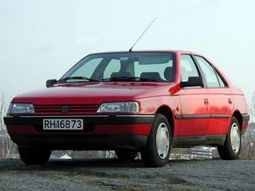
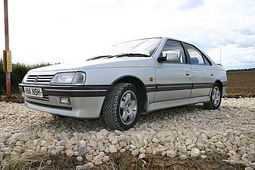
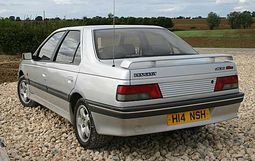
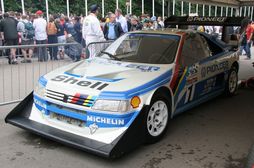
|